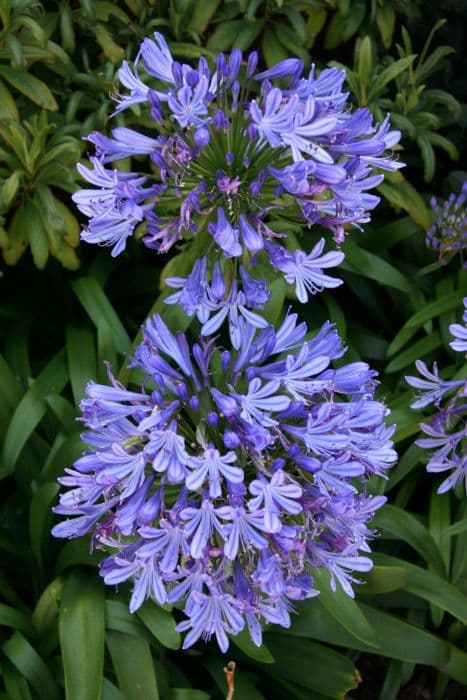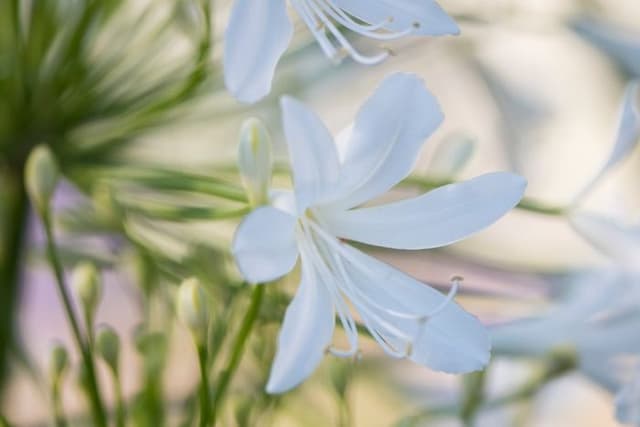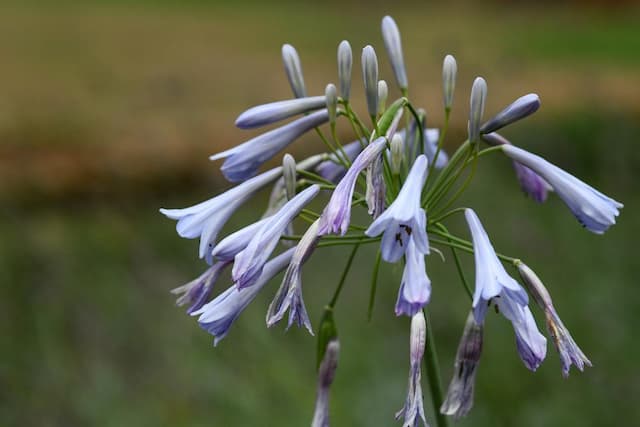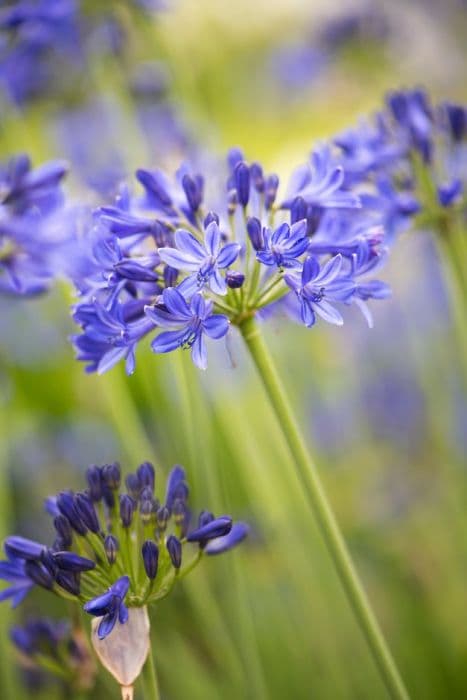African Lily Agapanthus 'Jonny's White'

ABOUT
Agapanthus 'Jonny's White', commonly known as the African Lily or Lily of the Nile, is a striking perennial plant that is widely admired for its elegant and showy flowers. The plant is characterized by its lush, strappy green foliage that forms a dense, fountain-like clump. The leaves are smooth and arch gracefully, creating a verdant backdrop throughout the growing season. The most prominent feature of African Lily 'Jonny's White' is its stunning floral display. The plant produces tall, sturdy flower stalks that rise elegantly above the foliage. At the top of these stalks, large, rounded clusters of flowers, known as umbels, form a magnificent display of blossoming beauty. Each umbel is densely packed with numerous trumpet-shaped flowers that are pure white in color, lending an air of sophistication and purity to the plant's appearance. The individual flowers are delicate and funnel-like with a subtle, pleasing contrast of brighter and softer tones of white. The blossoms may attract pollinators, adding movement and interest to the garden setting. The bloom phase of African Lily 'Jonny's White' can create a visually impressive display, making it a favorite for gardeners looking to add a touch of elegance to their borders, beds, or container plantings. In summary, Agapanthus 'Jonny's White' adds a touch of refined beauty to the garden with its exquisite white blossoms, lush green leaves, and overall majestic presence. Its appeal lies in its ability to draw the eye upward and serve as a focal point or complement other plants with its clean, crisp blooms.
About this plant
 Names
NamesFamily
Amaryllidaceae
Synonyms
African Lily, Lily of the Nile
Common names
Agapanthus 'Jonny's White'
 Toxicity
ToxicityTo humans
Agapanthus, commonly known as Lily of the Nile or African Lily, is considered to have components that can be toxic to humans if ingested. These toxic constituents are primarily found in the sap and can lead to symptoms such as nausea, vomiting, and diarrhea if consumed in significant quantities. In some cases, people may also experience dermatitis when coming into contact with the sap due to skin irritation. It is important to handle the plant with care and to ensure that its parts, especially the bulbs, are not ingested to avoid these toxic effects.
To pets
Agapanthus, or Lily of the Nile, has toxicity concerns when it comes to pets. If a pet, such as a cat or dog, ingests any part of the plant, it could result in symptoms similar to those seen in humans, including vomiting, nausea, and diarrhea. In severe cases, ingestion can also lead to more serious symptoms like tremors or an increase in heart rate. It is crucial to keep this plant out of reach of pets and to seek veterinary care if you suspect your pet has consumed any part of a Lily of the Nile.
 Characteristics
CharacteristicsLife cycle
Perennials
Foliage type
Evergreen
Color of leaves
Green
Flower color
White
Height
2 feet (0.6 meters)
Spread
2 feet (0.6 meters)
Plant type
Bulb
Hardiness zones
8
Native area
South Africa
Benefits
 General Benefits
General Benefits- Attractive Blooms: Agapanthus, commonly known as Lily of the Nile, features striking white flowers that are eye-catching in any garden setting.
- Drought Tolerance: Once established, Lily of the Nile is quite drought-resistant, making it suitable for water-wise gardens.
- Low Maintenance: This plant requires minimal care once established, making it a convenient choice for busy gardeners.
- Long Blooming Season: Lily of the Nile typically has a long flowering period, which can last several weeks throughout the summer.
- Attracts Pollinators: Its blossoms attract bees, butterflies, and hummingbirds, aiding local ecosystems.
- Border Planting: With its neat clumping habit, Lily of the Nile is ideal for use in borders or as edging plants.
- Container Gardening: Agapanthus is suitable for container planting, where it can thrive on patios or balconies.
- Cut Flowers: The blooms make excellent cut flowers for indoor arrangements due to their long vase life.
- Versatile Use: Lily of the Nile can be planted in mass for a dramatic effect, or used as a specimen plant to accentuate garden areas.
- Frost Tolerance: It can tolerate light frost, which makes it suitable for gardens in temperate climates.
 Medical Properties
Medical PropertiesThis plant is not used for medical purposes.
 Air-purifying Qualities
Air-purifying QualitiesThis plant is not specifically known for air purifying qualities.
 Other Uses
Other Uses- Artistic inspiration: The striking white flowers of Agapanthus can be used as a subject in photography, painting, or botanical illustration, capturing the plant's elegance in various forms of art.
- Garden design: Agapanthus 'Jonny's White' can be strategically placed in a garden to create white-themed garden designs or moon gardens that emphasize white and light-colored plants for nighttime viewing.
- Educational tool: Educators and parents can use the plant to teach children about plant biology, pollination, and the lifecycle of a perennial flowering plant.
- Floral crafts: The stems and blooms can be used in dried flower arrangements or potpourri, adding fragrance and visual appeal to a room.
- Dye source: While not commonly used for this purpose, the flowers could potentially be used to derive natural dyes for textiles or art projects.
- Culinary decoration: The flowers are not commonly eaten but could be used as an elegant, non-toxic garnish for special dishes, such as cakes or desserts, for events like weddings.
- Photographic project: Horticulture enthusiasts and photographers might use Agapanthus in time-lapse photography to document the stages of growth and blooming.
- Mood enhancement: The serene appearance of the white flowers can be utilized in landscapes or indoor settings to create a calming atmosphere and enhance mental well-being.
- Event décor: Due to their aesthetic appeal, the flowers can be used for decorative purposes in various events such as garden weddings or other outdoor celebrations.
- Aquatic garden compatibility: Agapanthus can be incorporated in an aquatic garden setup, provided they are planted in well-drained areas near the water but not submerged.
Interesting Facts
 Feng Shui
Feng ShuiThe Lily of the Nile is not used in Feng Shui practice.
 Zodiac Sign Compitability
Zodiac Sign CompitabilityThe Lily of the Nile is not used in astrology practice.
 Plant Symbolism
Plant Symbolism- Love Letters: The Agapanthus is often associated with love and is believed to represent a love letter or a message to a loved one.
- Beauty: Known for their striking blooms, Agapanthus symbolizes beauty and admiration, signifying the possession of inherent beauty, both physically and spiritually.
- Enduring Love: The plant's hardiness conveys the message of enduring or lasting love, suitable for relationships that have stood the test of time.
- Homecomings: With its South African origins, the Agapanthus can symbolize a safe return or homecoming as it naturally aligns with the plant's inherent tendency to thrive after traveling.
- Fertility: Due to its lush, full blossoms and rapid growth, this plant can be associated with fertility and abundance.
- Friendship: Its clustered flowers, which bloom together, embody unity amongst diversity, often representing the bonds of friendship.
 Water
WaterLily of the Nile, commonly known for its variety 'Jonny's White', should be watered thoroughly when the top inch of the soil feels dry to the touch. During the active growing season in spring and summer, watering might be needed every week, depending on the climate and weather conditions, using about one gallon of water per plant each time. During the winter, reduce watering to once every couple of weeks, or even less if the plant is in a cooler environment, as overwatering can lead to root rot. Always check the soil moisture before watering, because the frequency of watering can vary greatly with environmental conditions.
 Light
LightLily of the Nile thrives best when positioned in full sun to partial shade. A spot that receives at least 6 hours of direct sun a day is ideal for optimal blooming and growth. In regions with very hot summers, providing afternoon shade can protect the plant from scorching. Never place Lily of the Nile in deep shade, as it will hinder flowering and may cause the plant to become leggy.
 Temperature
TemperatureLily of the Nile prefers a temperature range of 60 to 75 degrees Fahrenheit during the growing season. It is cold-hardy in USDA zones 8 to 10, which means it can tolerate minimum temperatures down to about 15 degrees Fahrenheit. However, optimal growth occurs when nighttime temperatures don't drop below 50 degrees Fahrenheit. It's important to protect the plant from frosts and freezes by bringing it indoors or providing a protective cover if temperatures regularly fall below this range.
 Pruning
PruningLily of the Nile benefits from pruning to remove spent flower stalks and any damaged or yellowing leaves. Deadheading after blooms have faded encourages more flowers. Usually, pruning is done after the flowering season, in late summer or early fall. The plant should be pruned at least once a year to maintain its shape and promote healthy growth.
 Cleaning
CleaningAs needed
 Soil
SoilThe African Lily (Agapanthus 'Jonny's White') thrives best in a soil mix that is rich, well-draining, and loamy, composed of two parts peat, two parts loam, and one part perlite or sand. The ideal soil pH for African Lily should be slightly acidic to neutral, ranging from 6.0 to 7.0, to promote healthy growth and abundant flowering.
 Repotting
RepottingAfrican Lily (Agapanthus 'Jonny's White') should be repotted every two to three years to refresh the soil and accommodate root growth. They prefer to be pot-bound, so only upsize the pot when it is noticeably necessary to prevent root rot.
 Humidity & Misting
Humidity & MistingAfrican Lily (Agapanthus 'Jonny's White') is tolerant of most humidity levels but does best in average to high humidity environments, without the need for any special humidity adjustments.
 Suitable locations
Suitable locationsIndoor
Place African Lily in bright indirect light and water regularly.
Outdoor
Plant in sun to part shade; enrich soil; water as needed.
Hardiness zone
8-11 USDA
 Life cycle
Life cycleAgapanthus 'Jonny's White', commonly known as Lily of the Nile or African Lily, begins its life cycle with seed germination, typically in spring when soil temperatures rise. The seedlings develop into vegetative plants with strap-like leaves and establish a strong root system. As the plant matures, it enters a phase of vegetative growth, during which it develops its characteristic foliage and stores energy for flowering. In summer, the mature Agapanthus produces tall flowering stalks topped with globular clusters of white flowers. After blooming, if pollination occurs, the flowers develop into seed pods, which eventually dry and release seeds for the next generation. The plant then enters a period of dormancy in the colder months, conserving energy for the next growing season.
 Propogation
PropogationPropogation time
Spring-Early Summer
Agapanthus 'Jonny's White', commonly known as Lily of the Nile, is most effectively propagated through division. The optimal time to divide and propagate these plants is in the spring or early fall. To propagate by division, carefully dig up an established clump of Agapanthus once it has become crowded, typically every 3 to 4 years. Gently separate the clump into smaller sections, ensuring that each new section has at least one or two growing points or fans of leaves. Replant these divisions at the same soil depth they were originally growing, spacing them about 12 to 18 inches (approximately 30 to 45 centimeters) apart to allow for ample growth. Water the new divisions thoroughly after planting to help establish them in their new locations. This method of division encourages rejuvenation and increased blooming in the following seasons.









